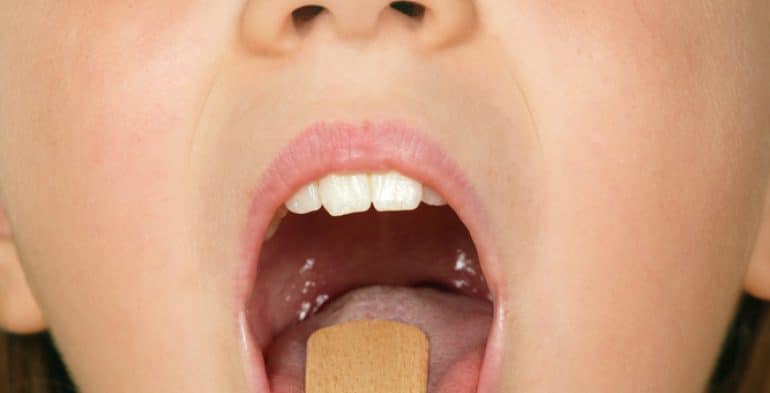
There are plenty of possibilities, but the most common cause of a sore throat is a virus, often a cold or flu. Viruses like mononucleosis can cause troublesome throat infections. And measles, chicken pox, and croup can also cause a sore throat. If the doctor diagnoses tonsillitis, it means that the bumpy tissue on either side of the back of your child’s throat is infected with a virus or bacteria.
The most common bacterial culprit is streptococcus (strep). Another bacterial infection that can cause a sore throat is whooping cough.
If your child is having trouble eating or is saying “it hurts,” it’s possible that she has mouth sores, like those caused by hand, foot, and mouth disease, canker sores, or gingivostomatitis. (Gingivostomatitis can also cause a sore throat.)
Irritants in the air – secondhand tobacco smoke, cat or dog dander, dust, and pollen from ragweed, grass, and trees – can also bother a child’s throat and trigger the cold-like symptoms known as allergic rhinitis, or hay fever.
Even dry heat can make it hard to swallow if your child tends to sleep with her mouth open. In this case, she may complain of a sore throat when she wakes up but feel fine as soon as she’s had something to drink.
Should I take my child to the doctor?
Bacterial infections can spread and damage other parts of your child’s body if left untreated, so it’s important to have the doctor take a look at your child’s throat if it’s anything more than dry or mildly irritated.
Also bring your child to the doctor right away if:
- his throat looks infected (bright red, swollen, or flecked with pus)
- he can’t swallow easily, open wide, or breathe without difficulty
- he has a stiff neck
- he has any signs of dehydration
- Check with the doctor if your child has:
- a fever higher than 103 degrees Fahrenheit
- a loss of appetite
- over-the-top crankiness
Is a sore throat ever an emergency?
The only throat condition that’s truly an emergency is epiglottitis, which is now extremely rare thanks to the Hib vaccine. An infection of the flap of throat tissue that prevents food and liquids from going down the windpipe, epiglottitis makes it hard to breathe as well as to swallow.
A child with epiglottitis quickly turns feverish (with a temperature above 101 degrees F), develops raspy breathing, and often drools. If your child has these symptoms, call a doctor immediately. If your child is having trouble breathing, call 911.
If you suspect epiglottitis:
- don’t try to examine her throat
- keep your child sitting up
- don’t offer her food or drink, as it could make breathing more difficult
If your child’s doctor thinks it might be epiglottitis, you’ll have to take your child directly to the emergency room for treatment.
How can I ease the pain of my child’s sore throat?
Home remedies like warm beverages – tea with honey, for example – can be soothing. So might a cold glass of apple juice, a bowl of ice cream, or an ice pop. Avoid giving your child citrus, which can irritate his throat. Once he’s around school age, you might try teaching your child to gargle with warm salt water (about 1/4 to 1/2 teaspoon per 8 ounces of water). Throat lozenges also provide relief for older children.
Keep in mind that it’s important to keep your child from becoming dehydrated, so even though it may hurt for him to swallow, he’ll need plenty of fluids, especially if he’s running a fever.
If your child is really uncomfortable, you may want to give him the appropriate dose of children’s acetaminophen or ibuprofen. Never give a child aspirin, which is associated with a rare but serious condition called Reye’s syndrome.
Try a cool mist vaporizer or humidifier in your child’s bedroom to moisten the air and soothe his throat. Just be sure to keep the filters clean or they can add germs to the air.







